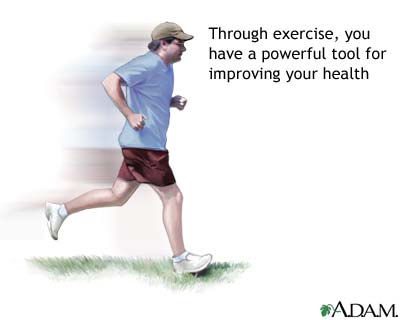Physical activity -- which includes an active lifestyle and routine exercise -- plus eating well, is the best way to stay healthy.
Information
An effective exercise program needs to be fun and keep you motivated. It helps to have a goal.
Your goal might be to:
- Manage a health condition
- Reduce stress
- Improve your stamina
- Be able to buy clothes in a smaller size
Your exercise program can also be a good way for you to socialize. Taking exercise classes or exercising with a friend are both good ways to be social.
You may have a hard time starting an exercise routine, but once you do start, you may begin to notice other benefits, such as:
- Better control of your weight and appetite
- Improved fitness, making it easier to do everyday activities
- Improved sleep
- More confidence in yourself
- Lower risk for heart disease, diabetes, and high blood pressure
GETTING STARTED
You do not need to join a gym to exercise. If you have not exercised or been active in a long time, start slowly to prevent injuries. Taking a brisk 10-minute walk twice a week is a good start.
Try joining a dance, yoga, or karate class if it appeals to you. You could also join a baseball or bowling team, or even a mall-walking group. The social aspects of these groups can be rewarding and motivating.
The most important thing is to do exercises that you can maintain and enjoy.
Important note: Talk with your health care provider before starting an exercise program if:
- You have diabetes, heart disease, lung disease, or another long-term illness
- You have obesity
- You have not been very active lately
- You get chest pains or shortness of breath when you are active
BUILD PHYSICAL ACTIVITY INTO YOUR REGULAR ROUTINE
Simple lifestyle changes can make a big difference over time.
- At work, try taking the stairs instead of the elevator, walking down the hall to talk with a co-worker instead of sending an email, or adding a 10- to 20-minute walk during lunch.
- When you are running errands, try parking at the far end of the parking lot or down the street. Even better, walk to the store or other nearby places.
- At home, do chores such as vacuuming, washing the car, gardening, raking leaves, or shoveling snow.
- If you ride the bus or other public transportation, get off at a stop before your usual stop and walk the rest of the way.
REDUCE YOUR SCREEN TIME
Sedentary behaviors are things you do while you are sitting still. Decreasing your sedentary behaviors can help you lose weight. For most people, the best way to decrease sedentary behaviors is to reduce the time they spend watching TV and using a computer and other electronic devices. All of these activities are called "screen time."
Some ways to decrease screen time are:
- Choose 1 or 2 TV programs to watch, and turn off the TV when they are over.
- Do not keep the TV on all the time for background noise -- you might end up sitting down and watching it. Turn on the radio instead. You can be up doing things around the house and still listen to the radio.
- Do not eat while you watch TV.
- Before you turn on the TV, take your dog or a neighbor's dog for a walk. If you are going to miss your favorite show, record it.
- Find activities to replace TV watching. Read a book, play a board game with family or friends, or take an evening cooking class.
- Work out on an exercise or yoga ball while you watch TV. You will burn calories. Or, set up a stationary bike or treadmill in front of your TV and use it while you watch.
If you like playing video games, try games that require you to move your whole body, not just your thumbs.

HOW MUCH EXERCISE DO YOU NEED?
The Physical Activity Guidelines for Americans recommends that adults get a total of 150 to 300 minutes per week of moderate-intensity activity, or 75 to 150 minutes per week of vigorous activity. You could also meet this recommendation with an equivalent amount of combined moderate and intense activity. Muscle strengthening, also called strength training, resistance training, or endurance exercise, should also be done 2 or more days a week. People age 65 or older should also do balance exercises.
As you become more fit, you can challenge yourself by increasing the intensity of your exercise by going from light to moderate activity. You can also increase the amount of time you exercise.
Alternative Names
Fitness recommendations; Exercise - physical activity
References
Kraus WE. Physical activity. In: Goldman L, Cooney KA, eds. Goldman Cecil Medicine. 27th ed. Philadelphia, PA: Elsevier; 2024:chap 14.
Mora S, Libby P, Ridker PM. Primary prevention of cardiovascular disease. In: Libby P, Bonow RO, Mann DL, Tomaselli GF, Bhatt DL, Solomon SD, eds. Braunwald's Heart Disease: A Textbook of Cardiovascular Medicine. 12th ed. Philadelphia, PA: Elsevier; 2022:chap 25.
Piercy KL, Troiano RP, Ballard RM, et al. The physical activity guidelines for Americans. JAMA. 2018;320(19):2020-2028. PMID: 30418471 pubmed.ncbi.nlm.nih.gov/30418471/.
Test Your Knowledge
Review Date 4/1/2025
Updated by: Linda J. Vorvick, MD, Clinical Professor Emeritus, Department of Family Medicine, UW Medicine, School of Medicine, University of Washington, Seattle, WA. Also reviewed by David C. Dugdale, MD, Medical Director, Brenda Conaway, Editorial Director, and the A.D.A.M. Editorial team.












